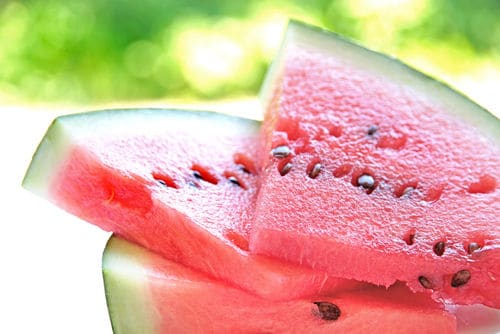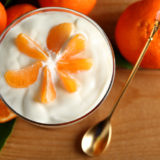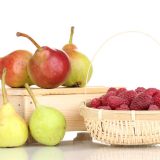

Who doesn’t love a nice cold slice of watermelon as dessert after a picnic? At only 84 calories per 10 oz wedge, watermelon is an excellent choice even before we consider the health benefits. They contain about 6% sugar, 91% water and are high in vitamins A and C.
Watermelon is well known as a natural diuretic, but also has some surprising antioxidant and heart health benefits.
Antioxidant Action
Antioxidants neutralize the free radicals in the body. While free radicals occur naturally, exposure to pollution, radiation, cigarette smoke and herbicides increases our levels of free radicals and, as a result, our potential risk of cancer. An excellent antioxidant is lycopene, which is linked to cancer prevention. In fact, studies have shown lycopene to be a significant factor in preventing prostate cancer. Watermelon contains about 40% higher lycopene concentration than raw tomato and ranks 5th among major lycopene containing foods in the U.S.
Cardiovascular Benefits
Watermelon also contains the amino acid L-citrulline, which can be converted to L-arginine in the body. L-arginine is an essential amino acid that relaxes blood vessels and improves circulation, contributing to heart health and lower high blood pressure.
Watermelon’s Valuable Nutrient
Another important nutrient in watermelon is choline, which helps us sleep, aids in muscle movement, learning and memory. Choline is vital to maintaining the cellular membranes, which allows for transmission of nerve impulses and the absorption of fat. Choline also reduces inflammation, and can reduce symptoms of chronic inflammatory conditions.
There are well over 500 types of watermelon grown worldwide, and there may be as many as 1,200 varieties. They are divided into two broad categories: icebox and picnic. Icebox types range from 5-15 pounds, while picnic types are larger. Almost everyone knows about the classic large, red watermelon we see in most grocery stores in the U.S., but there are also seedless varieties and even yellow watermelons regularly available in our grocery stores.
Growing Your Own Watermelon
There are many more types of watermelon available than what you see in the grocery stores. If you are planting watermelons, take a look at the varieties of heirloom seeds, or seeds that are harvested from prior plantings on a local basis rather than those seeds available through commercial means.
- Watermelons need temperatures over 77 degrees and do best in sandy or well-drained soil.
- They can be started indoors in cooler climates.
- Watermelons may be attacked by aphids, fruit flies and possibly other bugs and do get plant diseases common in gardens.
- This fruit typically takes about 85 days to mature and should be in a “full sun” location.
- Create mounds two to four feet apart, and plant in the center of these about 1″ deep.
- Sprouts will usually appear in about 7-10 days.
- When they are ready, cut the watermelons from the vine.
- They will last about 10 days once cut.
Fun Fact About Watermelons: One of the most interesting watermelon growing techniques is that of the Zentsuji region in Japan, where they grow watermelons in glass boxes where they take on the shape – a cubic watermelon!




